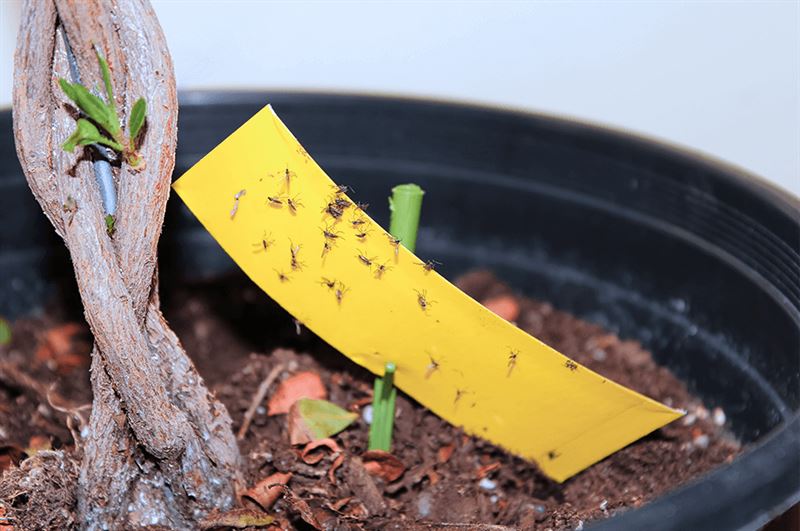
4 Common Plant Pest Hiding Spots
By Kaw Valley Greenhouses, Inc.

While some pests and infestations in our houseplants or garden may be obvious, sometimes things are a bit trickier to spot. Knowing where to look and how to identify pests is key to keeping your plants healthy and thriving. Here are some common places to check for plant pests.
 1. Leaves and Stems
1. Leaves and Stems
Some pests, like spider mites, cabbage worms, aphids, or mealybugs, may hide or lay eggs only on the underside of leaves and where the leaf meets the stem. Spider mites can be particularly difficult to spot because they are so tiny, so check the underside of leaves for signs of their webbing. A bright light, like your smartphone flashlight, might come in handy for this.
Another sneaky place where pests like to hide is the stems of the plant. Aphids especially like the soft new growth of stem tips on many vigorous growers, but can easily blend in unless looked at closely. Alternatively, there are some pests that will lay eggs at the base of stems that hatch and bore through the stem of the plant, eating as it moves up through the plant. The squash vine borer is a common example. If your plant seems wilty though it is watered, you may want to inspect the base of the stem for signs of borers including holes or frass (the excrement of the insect that resembles sawdust.

Treatment Plan:
When you suspect the leaves or stems of your plants are infested, there are a few different approaches you can take to treatment, depending on the type and severity of infestation. You can attempt to remove many types of plant pests manually with a hard stream of water, with your fingers, or even a little creativity and a handheld vacuum.
Neem oil, a natural pesticide, will effectively treat most infestations on garden and houseplants, as long as they aren’t too severe.
Prevention:
Pests seek out plants under stress, taking care of your plants' needs is the first line of defense. To prevent pests from creeping onto your plant’s leaves and stems make sure your plants are properly watered—not too wet, not too dry—and ensure that the plant is getting adequate humidity (spider mites love low humidity). Try having a regular “inspection party” where you check each of your plants for signs of pests. For houseplants, you can wipe down leaves regularly to remove dirt, debris, and whatever bugs you come across!
Always be on the lookout for signs of pest damage on your plants: yellowing or wilting leaves, lack of growth, foreign substances on the leaves, or a shiny sticky residue. All are signs that you should do a thorough inspection and treatment. Since many of these insects are likely to stay in one place while they eat, it is often easy to spot their excrement as it will fall onto leaves below them. Honeydew is a shiny sticky residue that gives away the presence of many insects that suck out plant juices like aphids. If the leaves look wet but instead those droplets are sticky you will want to check very closely the undersides of leaves and stems in that area. In many cases this honeydew will cause ants to enjoy this sweet substance, so if you see ants running up and down stems there may also be a reason to inspect.
 2. Dig Into Soil
2. Dig Into Soil
Sometimes you have to dig a little deeper to identify any plant pests. Cutworms are a common issue on young transplants and can devastate overnight by chewing a ring around the base of the stem so that in most cases the plant just falls right over as thought had been hit by a string trimmer. These guys usually strike overnight. Moles and voles are also plant pests at times as voles feed on plant roots, and mole tunnels can also cause damage if they overly disturb a plant's roots during tunneling. Fungus gnats may lay eggs just below the soil surface of your houseplants. Sometimes you can see adult fungus gnats scurrying over the top of the soil or flying around your plants. Adult fungus gnats likely won’t do much damage to your plants, but their larvae eat organic matter in the soil and often feed on your plant’s roots.
Treatment Plan:
If you want to get rid of fungus gnats, you can try replacing the top layer of soil or soaking the soil with a mixture of one part 3% hydrogen peroxide to 4 parts water to kill off the fungus gnat eggs and larvae.

Prevention:
Ensuring healthy soil is the best prevention for all soil-based pests. You can have it tested for fertility and composition through your county’s extension service. Minimizing the amount of disturbance in the soil (only tilling when needed for example) can help keep the balance of soil organisms so that the bad won’t outweigh the good.
Although your garden soil may be very healthy, never bring outdoor soil inside for your houseplants. Instead, use high-quality commercial soil to reduce the risk of transferring harmful plant pests inside.
To reduce the risk of fungus gnat infestation on houseplants, don’t over-water! Use only the minimum amount of water to satisfy your plant’s needs, so that you don’t accidentally invite these pesky gnats to move in.
Cutworms are easy to prevent by making sure to clean up piles of leaves in the fall, which is where cutworms tend to hide. If you do want to plant in an area where there has been leaf debris for some time you may want to wrap an aluminum foil collar around the stem base to block any feeding since cutworms may be present. Simply remove the collar as the plant grows and is no longer susceptible.
 3. Weeds Nearby
3. Weeds Nearby
Weeds themselves can be pests to your garden because they directly compete with your desired plants. However, they also pose an additional threat as they can hide diseases and thriving populations of insect pests whose next buffet stop might be right where you don’t want them. Though it may not be feasible to check weeds for insect pests (since you might as well pull them) it is good to be aware that they also include all of the previously mentioned hiding spaces.
Treatment Plan:
The easy solution is to get rid of weeds around your garden area so that they can't provide shelter for pests. If you are a more experienced gardener you may be able to use certain weeds to help anticipate pest populations because you may notice trends over the years. Some organic growers utilize banks of weeds to deter pests from desired crops because they can then treat those areas more harshly. Alternatively, some weed species also act as hosts for predatory insects. Sometimes this is because they’ve found their own buffet of pest insects. This does make things a bit more complicated, but if you're interested in experimenting with trap crops or beneficial beetle banks, it can be an interesting biological experiment so be sure to get the kids involved!
Prevention:
Mulch is key to preventing more weeds and it will also help make sure that your plants are less stressed in the first place. Using straw in the vegetable garden will prevent weeds from sprouting and also allows for hiding places for spiders who are excellent pest eaters.
 4. Old Pots and Containers
4. Old Pots and Containers
One great reason to thoroughly clean your pots and containers? To prevent plant pests! This is particularly important if you have repotted or disposed of a plant that was previously unhealthy. No matter the situation, cleaning old pots and containers is key to preventing the transfer of both pests and disease.
Treatment Plan:
Thoroughly clean and disinfect your ceramic and plastic pots with a water and bleach mixture (1 part bleach to 9 parts water.) Soak them in the mixture for about 10 minutes. For clay pots, take a wire scrubber and make sure all debris is gone, then soak. It’s good practice to soak them well before use.
Prevention:
Stay on top of your pot hygiene! Cleaning pots thoroughly as soon as you have removed the plant is good practice and much easier than treating preventable plant pests.
Now that you’ve got some idea of where and what to look for, you’re on the right track to prevent, treat, and troubleshoot any gardening issues as they arise!

